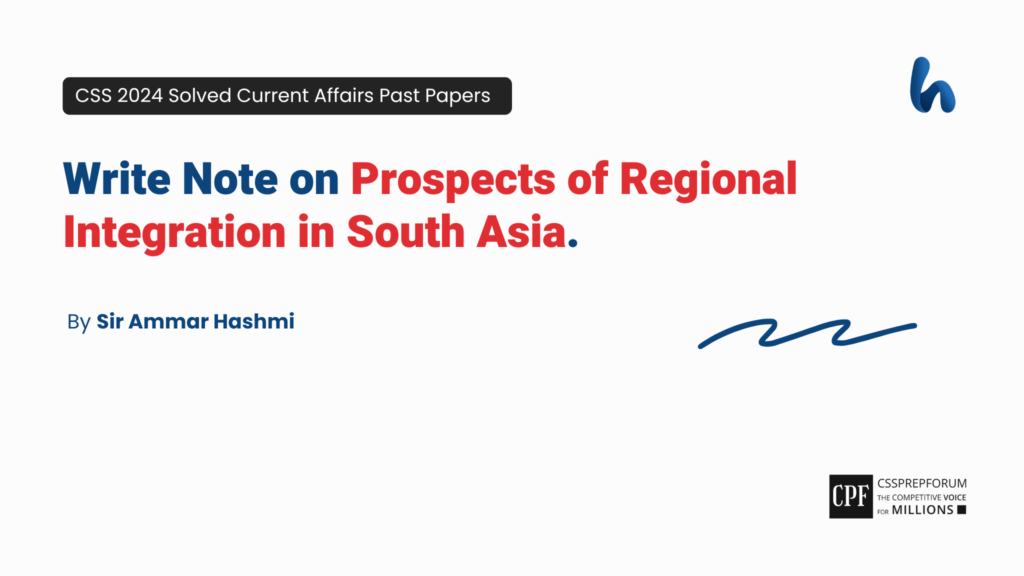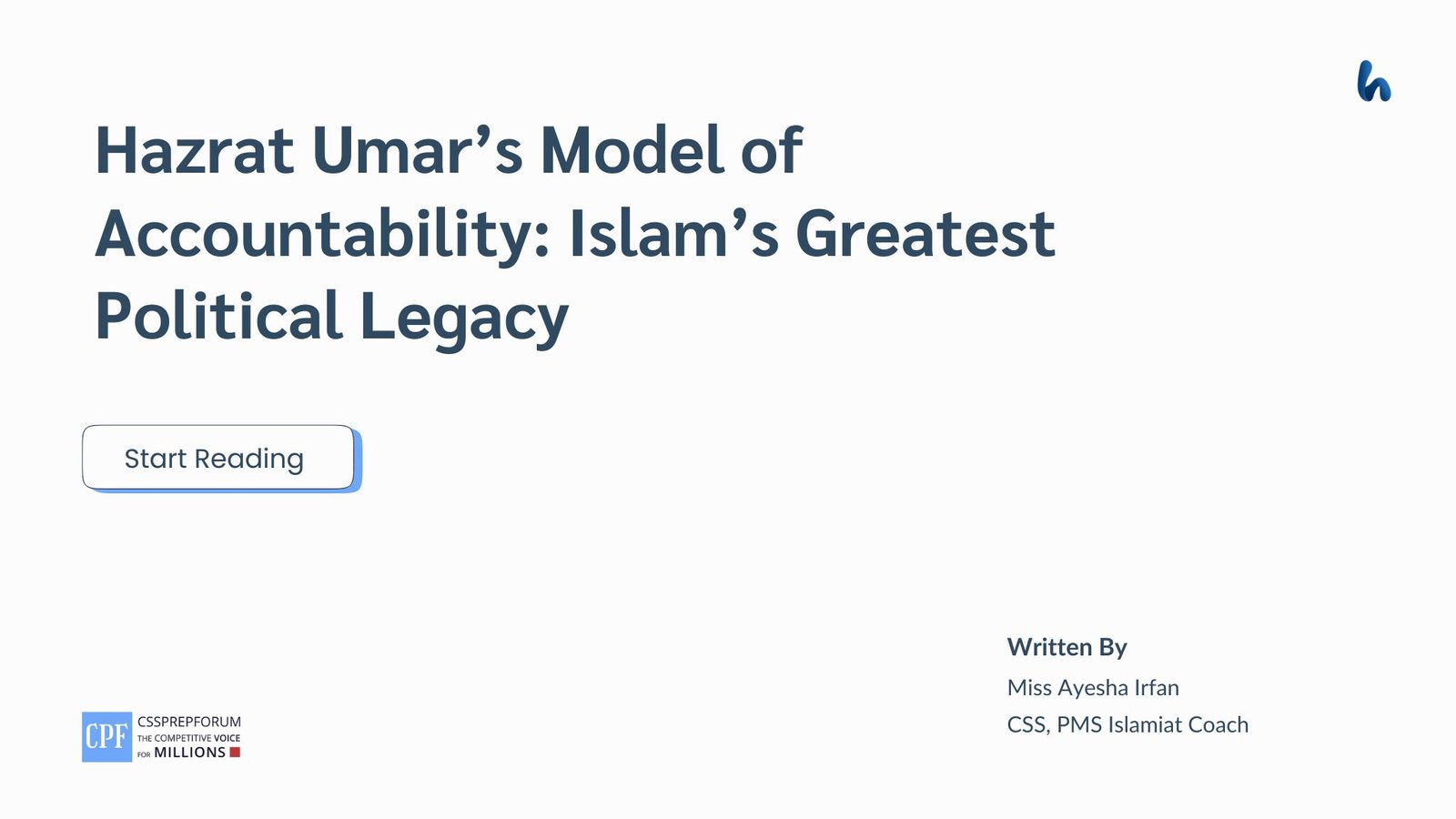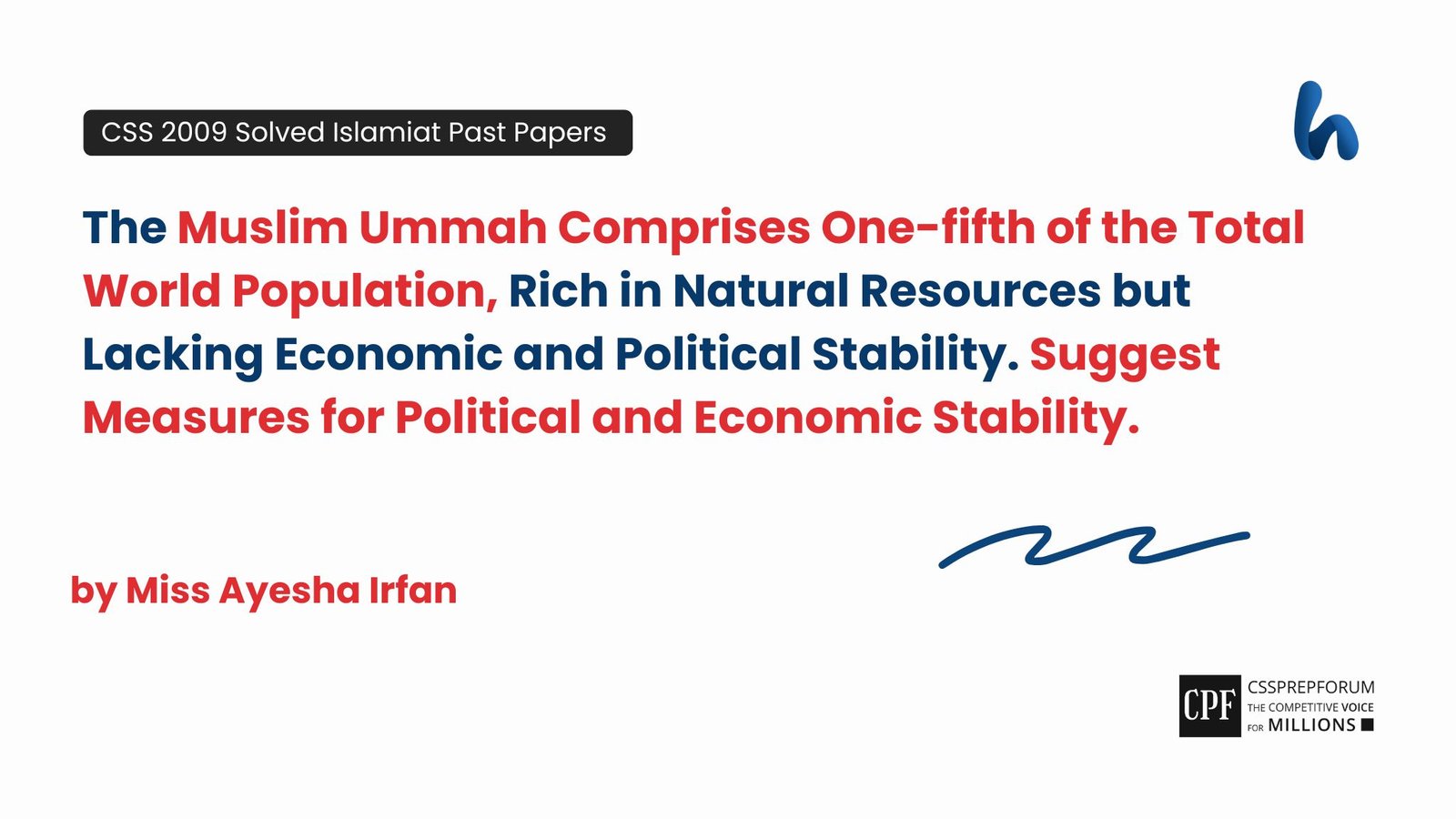CSS 2024 Solved Current Affairs Past Papers | Write Note on Prospects of Regional Integration in South Asia.
The following question of CSS Current Affairs 2024 is solved by Sir Ammar Hashmi, the best Current Affairs Coach, on the guided pattern of Sir Syed Kazim Ali, which he taught to his students, scoring the highest marks in compulsory subjects for years. This solved past paper question is uploaded to help aspirants understand how to crack a topic or question, how to write relevantly, what coherence is, and how to include and connect ideas, opinions, and suggestions to score the maximum.

Question Breakdown
Highlighting futuristic expectations of regional integration in South Asia
Outline
1-Introduction
2-A glance at South Asia in a geographical context
3-The importance of South Asia in the World
4-Prospects of regional integration in South Asia
- ✓Economic Opportunities
- Evidence: South Asia Regional Cooperation and Integration: Opportunities and Challenges, Asian Development Bank (2020).
- ✓Political and Security Dimensions
- Evidence: South Asia: Building Trust in Regional Security, International Crisis Group (2023).
- ✓Socio-Cultural Integration
- Evidence: Cultural Integration in South Asia: Opportunities and Challenges, UNESCO (2022).
- ✓Economic and Trade Agreements
- Evidence: Trade and Integration in South Asia: An Overview, World Bank (2023).
- ✓Environmental and Sustainability Challenges
- Evidence: Climate Change and South Asia: Regional Impacts and Responses, Intergovernmental Panel on Climate Change (2021).
5-Critical analysis
6-Conclusion

Answer to the Question
Introduction
Regional integration can become the epitome of success for regional countries like the European Union. Similarly, the regional integration of South Asia also presents various prospects. However, some constraints can hinder the implementation of the regional integration policy in the South Asian region. South Asia includes India, Pakistan, Bangladesh, Sri Lanka, Nepal, Bhutan, and the Maldives and has unique cultures, economies, and politics. In the case of regional integration, equal prospects, including trade, infrastructure, and resources, are likely to be realized. Organizations such as the South Asian Association for Regional Cooperation (SAARC) can prove pivotal to solving problems and encouraging economic development in the region. However, integration efforts meet challenges due to political enmity, past hostilities, and varying economic agendas. The surmounting of these challenges could bring about a strengthened integration and cooperation of the member states, resulting in a more robust economic front within the region and possibly a better voice internationally. However, in the context of the evolving geopolitics in contemporary South Asia, the future of such regionalism presents an interesting factor that may influence the South Asian economies dramatically.
Explaining South Asia as a region
South Asia is an expanse that covers the countries of India, Pakistan, Bangladesh, Nepal, Bhutan, and Sri Lanka, whose geography is highly diverse. In the north, the Himalayas are a well-known mountain range with many towering peaks, such as Everest, K2, etc. South of them is the fertile Indo-Gangetic Plain, India’s breadbasket. In the northwest, the Thar Desert illuminated the Deccan Plateau during its blossoming in Central India. The West and East Ghats are the two mountainous ranges, excluding the coastal areas. The presence of plant life is influenced by climate. Sri Lanka has a mountainous landscape, and the Maldives has multiple tiny coral atolls. Large tributaries of the Indus, Ganges, and Brahmaputra rivers are these areas’ life blood that depend on monsoon rains for their climate and agriculture.
Importance of South Asia in the world
South Asia is highly important globally due to its economic potential, strategic location, and cultural influence. Its population is over 1.8 billion people, making it a significant market and workforce center, with India and Pakistan being the leading political powers in the region. The region’s rapid economic growth, particularly in technology and services, affects world trade and investment. South Asia’s rich cultural heritage and history are added to the global arts, literature, and spirituality to a large extent. Its strategic location, which allows it to reach all major maritime routes, makes it a privileged point in geopolitics, influencing global energy supplies and international trade dynamics.
Prospects of regional integration in South Asia.
- Economic Opportunities
Overall, regional integration into South Asia offers excellent economic opportunities. The primary type of cooperation in the South Asian Association for Regional Cooperation (SAARC) is to improve the economic interaction in different states by enhancing trade and investment. Integrating or adopting a new model could see the organization gaining better access to relevant markets, better foundations, and a diverse economy. Recent research by the Asian Development Institute illustrates that regional integration could increase intra-regional trade and investment, contributing $44 billion to the area’s gross domestic product (GDP) before 2025. However, some challenges affecting the area include political risk factors and trade restrictions, which must be addressed if these benefits are to be fully captured.
- Political and Security Dimensions
When analyzing the potential of regional integration, it is necessary to mention that political and security aspects are the most important in South Asia. Political rivalry, accentuated by history and hostility, is a factor that makes cooperation difficult, especially between India and Pakistan. Nevertheless, conflict resolution and the confidence-building process may help in the integration. The action in this aspect seems a significant impediment, but steps like the Kartarpur Corridor prove that diplomacy can and will be done (International Crisis Group, 2023). Security architectures within a region and cooperation are crucial in building an environment that will allow integration in the best way possible.
- Socio-Cultural Integration
Integration of socio-cultural activities and practices is, therefore, very crucial when it comes to promoting togetherness and mutual respect among people in a region. These are some of the most profound bases of unity; multiple links include cultural similarities, languages, and traditions. Efforts to encourage students, scholars, teachers, artists, and tourists from the two countries can improve mutual understanding (UNESCO, 2022). Efforts towards enhancing the celebration of South Asian cultural celebrations and academic exchange have been effective in curbing several divides and encouraging regional affinity (South Asian Cultural Forum, 2021).
- Economic and trade agreements
Applying economic and trade agreements can enormously influence the territory’s integration. The South Asian Free Trade Area (SAFTA) can curb trade barriers by reducing and increasing economic cooperation among member countries. However, it is ineffective due to non-tariff barriers and political disputes, majorly among the two significant regional powers, Pakistan and India (World Bank, 2023). Increasing trade cooperation through new trade agreements and improving connectivity infrastructure are the main ways to realize benefits from regional integration (International Energy Agency, 2021).
- Environment and sustainability prospects
Environmental and sustainability challenges are crucial for regional integration. One of the significant concerns of South Asia is climate change, which leads to resource depletion and environmental degradation. The approach to these problems calls for the utilization of joint management of transboundary resources and the formulation of joint environmental policies that can be achieved through regional cooperation (Intergovernmental Panel on Climate Change, 2021). Regional integration strategies must consider the environmental aspect to achieve sustainable development of all member nations (South Asian Environmental Coalition, 2022).
Critical analysis
While regional integration in South Asia carries many economic and cultural advantages, the process is fraught with obstacles. Political tensions, especially between India and Pakistan, and complicated trade barriers restrict integration. Environmental problems further thicken the effort for integration, which requires sustainable solutions to address them. The ability to remove these complex obstacles through cooperation and the right policies will significantly influence successful integration.
Conclusion
South Asia is a region where integration can bring miraculous results in economic development, cross-border unification and joint problem-solving. On the other hand, addressing political conflicts among the countries and improving trade cooperation and environmental protection policies are the main aspirations towards achieving the objectives. A joint effort by all the member states and encouraging sustainable and inclusive policies are the only ways to accomplish these prospects.

CSS 2024 Solved Current Affairs
CSS Solved Past Papers’ Essays
Looking for the last ten years of CSS and PMS Solved Essays and want to know how Sir Kazim’s students write and score the highest marks in the essays’ papers? Then, click on the CSS Solved Essays to start reading them.
CSS Solved Essays
CSS Solved General Science & Ability Past Papers
Want to read the last ten years’ General Science & Ability Solved Past Papers to learn how to attempt them and to score high? Let’s click on the link below to read them all freely. All past papers have been solved by Pakistan’s top CSS GSA coach having the highest score of their students.
General Science & Ability Solved Past Papers












